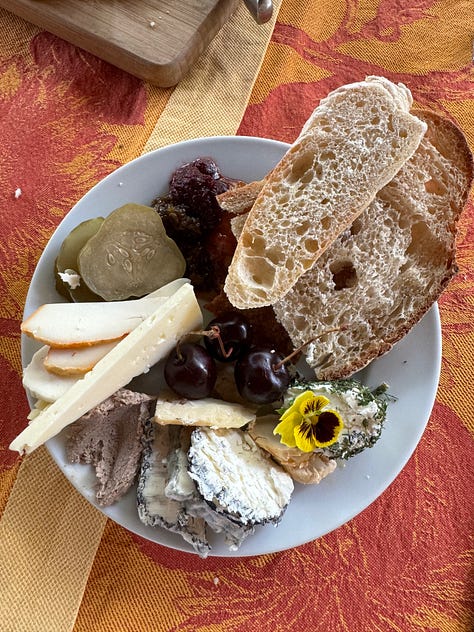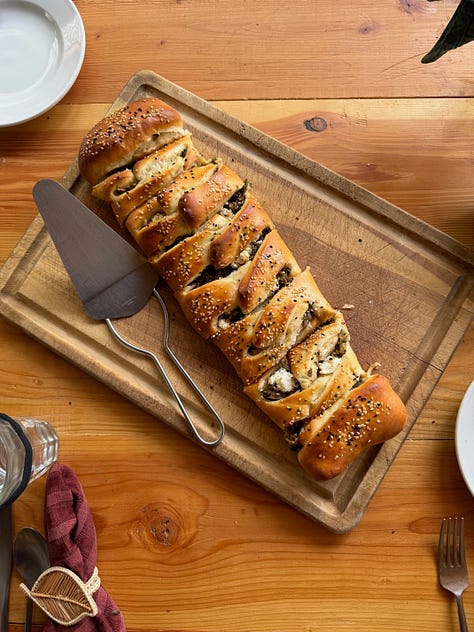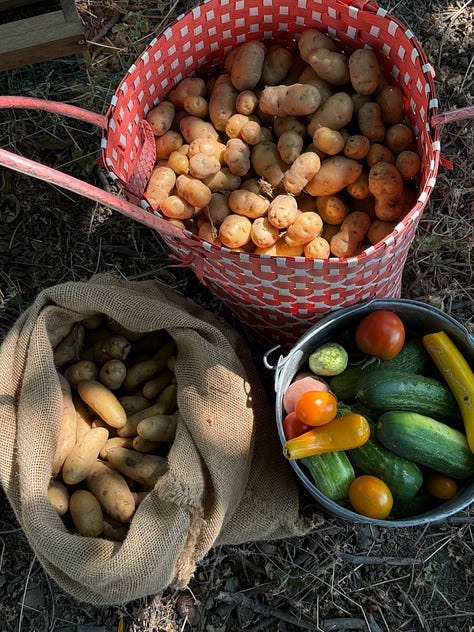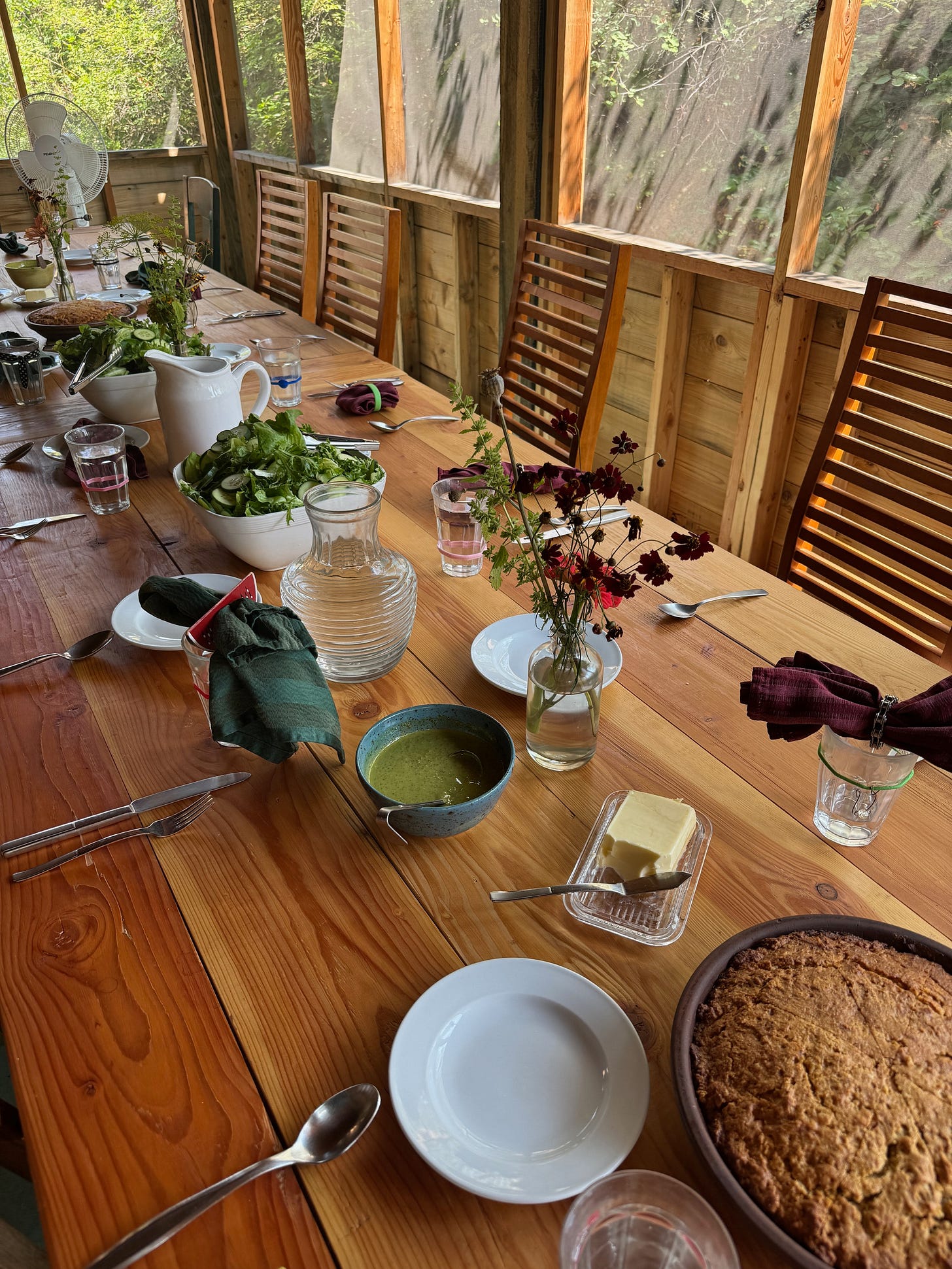Hello friends! I hope all of you have been having a bountiful summer.
Living in the Pacific Northwest, there is an energy that comes around each summer. It feels like everyone and everything is moving at a hundred miles per hour. And I can’t help but feel some sort of “sun guilt” when I glance outside my window to a perfectly blue sky while I am sitting inside answering unread slack messages and trying to dowse artificial fires that live in the confines of my computer screen.
This July, I met a couple, Rick and Laura Lee Misterly, who over forty three years ago decided that they would never feel sun-guilty, or worry about a fire that wasn’t actively threatening their soil. From bare ground, to a home, to eventually a farm, cheese business and now a school, Rick and Laura Lee have dedicated their lives to living mindfully, slowly and in harmony with nature.
Below, I will be diving into some of these lessons. However, I will give a gentle trigger warning that one lesson involves butchering a chicken. If you are sensitive to this experience, I will give you another warning below so you can skip to the next paragraph.
Before we dive in, thank you for being a supporter of Sobremesa! Sharing life’s happenings with you and the thoughts that live inside my head and eventually make it out onto paper (or screen) is a gift and I am grateful that I have this medium to connect with all of you.
She waved at me as she opened the trunk for me to put my luggage in. “Hi, I’m Anjean.” We had never met before, but for the next six hours, we drove through the ever-changing landscape of Washington, from towering trees to rolling hills, farms, and burnt grass under expansive skies. Wildcat by Ratata played in the background as we shared stories about our families and exchanged tips on saving our voices. It turns out both of us had dealt with straining our vocal cords in the past.
This wasn't my first time agreeing to a kind of "speed date" to reach a destination where I also didn’t know anyone. The first time was on my way to a meditation retreat earlier this spring. Just like that occasion, I could already sense that although I arrived alone, I would be leaving with new connections and friendships.
As we neared our destination, the last twenty miles involved following the serpentine path of the Columbia River, which dazzled us with sunlight reflecting off the water like thousands of mirrors. “It helps your voice if you blow air onto your straw, like this,” Anjean said, as we both blew bubbles into leftover coffee cups like children, completely missing our turn.
Turning right on Pleasant Valley Road, past a small church and up a little hill, we arrived at the red-roofed house that would become our home for the week. The entryway opened into a large kitchen, featuring a table long enough to seat over fifteen people comfortably. It was the kind of place where we gathered at all hours, but my favorite room was an adjacent space—a greenhouse-like addition to the original structure. This room, with its own large wood table and ample natural light, was a sanctuary where you could spend an afternoon immersed in Laura Lee and Rick’s extensive cookbook collection.
Our first meal at the farm was an array of hors d'oeuvres celebrating local bounties: goat cheese, fermented vegetables, homemade bread, chicken pâté, and sweet jams. I went to bed with a full stomach, but it wasn’t the food keeping me awake. I was reflecting on the next morning’s challenge: butchering my first chicken.



Trigger warning: The following paragraphs discuss this experience. If you’re more comfortable skipping ahead, please do so to the next break line.
I’ve always loved animals, growing up surrounded by them, which has deepened my appreciation and desire to protect them. At the same time, I’ve always been a meat eater with aspirations of self-sustainability, nourishing my body from the land I live on. Learning to butcher a chicken was a daunting, emotional, but necessary step toward that goal. To raise chickens and be truly sustainable, I needed to confront the full cycle of my food, not just be a consumer.
When my alarm went off at 5 a.m., I woke to the soft, red-tinted skies of fire season in the Northwest and made my way to where Rick was waiting. Without hesitation, he handed me one of the chickens destined for our weekend meal. I grasped its feet as it flapped its wings momentarily before relaxing. Feeling its warmth through my gloves, I closed my eyes and whispered thank you, steadying my own heart rate for both of our sakes.
Rick placed each chicken into “cones,” quickly cutting off their heads. This was the most intense part, and although watching Lucy, the farm dog, eat each one for breakfast was shocking, I found comfort in knowing that no part of any chicken went to waste. The chickens then went through a hot water bath with Dawn dish soap to loosen their skin before being plucked by the StarPluck machine—a farm device resembling a washing machine that removed about 90% of the feathers. We finished the job by hand, guided by Rick, transforming each chicken into what we usually see wrapped in plastic at the grocery store.
Throughout the process, I marveled at the autonomy of the small body before me and felt awe for the mechanisms sustaining life. From the neck to the liver, we kept all possible edible parts and added the rest to a special compost, returning nutrients to the soil that sustains the farm’s plants.
I didn’t cry during the butchering, but after breakfast, as we discussed the experience, my emotions surfaced. That morning taught me a profound lesson about waste. The act of killing the chickens affirmed the interconnectedness of life. How can we, after witnessing the full cycle of our food, justify overcooking and discarding food out of distraction?
Moving forward, I vowed to use all my power to ensure that everything I cook is not only beautiful but treated with respect for the life that sustained it. Even a vegetable making it to our kitchen is a miracle, given the effort required to grow it from seed to a blushing tomato on our counter.
Given our convenience of accessing produce and proteins from grocery stores, how can we not consider the effort it took to get them there? If each of us had to butcher our meat or grow our produce, would we then scroll through our phones, or be foolish to other distractions while cooking? No.
It’s a simple yet profound lesson that has forever changed how I approach cooking. Eating is an environmental act. In the U.S. and many parts of the world, we have the privilege of choosing where our food comes from. We can choose to participate in our community or simply consume. Eating offers a chance to reconnect with our humanity.
You might not have reached this part of the newsletter, not out of fear of the explicit details, but perhaps because you thought, “I simply don’t have time.” I’ve been there too, especially recently, feeling engulfed by work and glued to my desk, fearing that stepping away would lead to chaos. This may sound dramatic, but how often do we find ourselves anxiously clicking from tab to tab, awaiting the next crisis? Such behavior is a stress reaction that can be balanced by slowing down.
Cooking is one of the most ancestral ways we have to find connection and slow down in our modern lives. You don’t have to butcher your own chicken to participate in the cycle of food and be part of it rather than just a consumer. You can attend farmer’s markets and learn about local growers, be mindful of seasonal and local produce, and put your phone away while cooking to let your senses guide the experience.
By embracing these practices, you not only enrich your eating habits but also reconnect with the rhythms of nature and community.
Homemade Cajeta
One of my favorite memories from the farm, was being able to utilize some of the goat milk and teach my fellow classmates how to make Cajeta.
Cajeta is a Mexican dessert that originated in my hometown of Guanajuato during the Mexican Revolution. While Dulce de Leche originated in Spain, it was Mexican soldiers who used goat milk for the first time to recreate the recipe and make a sweet sauce that they used for energy during the war efforts. This sauce got it’s name “Cajeta” from the round cajas (boxes) named cajetas that soldiers used to store the candy.
Cajeta is fairly easy to make, and it’s delicious as a spread on toast, a sauce on ice cream and other desserts or simply by the spoonfull.
Ingredients:
1 vanilla bean
4 cups goat milk
3/4 cup of granulated sugar
1/2 teaspoon baking soda
1/8 teaspoon sea salt
Method:
- Split the vanilla bean with a paring knife and scrape out seeds with the flat of the blade; reserve the seeds for another use.
- In a large pot, combine the split vanilla pod, goat milk, sugar and baking soda. Warm over medium heat, stirring occasionally with a heat-resistant spatula, until sugar dissolves and the milk turns foamy and light, about 15 minutes.
- Continue cooking the milk at a gentle simmer, stirring and scraping the sides of the pot frequently until milk becomes thick, golden, and reduced to no more than a thing, super-jammy layer, about an hour.
- Stir more frequently as the cajeta (caramel) thickens to prevent burning. Continue simmering down until the cajeta leaves a trail that remains open for one second when a spatula is scraped across the bottom of the pot.
-Stir in the salt to mix. Remove from heat, and using a spoon remove and discard the vanilla pod.
-Scrape cajeta into a heat-resistant, wide mouth glass jar. Cajeta can be refrigerated for up to three months.
Book your own Farm Trip
If you’re interested in learning from Laura Lee and Rick, you can visit them at Quillasascuit Farm or book your trip through The Pantry as my group did.
New Cooking Classes
Speaking of The Pantry, I am teaching a few classes this Fall and Winter! We are kicking off the season this month with two Mexican Coastal Classes. Hope to see you there!






